![]()
![]()
![]()
Use LEFT and RIGHT arrow keys to navigate between flashcards;
Use UP and DOWN arrow keys to flip the card;
H to show hint;
A reads text to speech;
17 Cards in this Set
- Front
- Back
|
What is functional anatomy |
Functional anatomy is taking the knowledge of the body structures that we learn and applying it to live, moving bodies |
|
|
What are the types of skeletal muscle contractions |
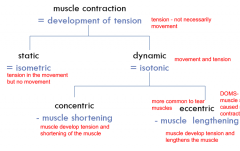
|
|
|
What type of muscle contraction is a isometric contraction |

Isometric contraction - occurs when tension is generated in a muscle - muscle length and angle of joint does not change - produces no movement |
|
|
What type of muscle contraction is a isotonic contraction |
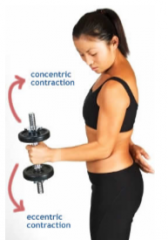
Muscle contraction that changes length - can increase length- eccentric - can decrease length- concentric |
|
|
What is a concentric contraction |
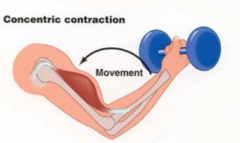
_Muscle contraction resulting in shortening of the muscle - overcomes external forces (ie. gravity) -Eg, lifting a glass |
|
|
What is a eccentric contraction |
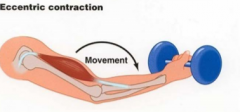
-muscle contraction resulting in lengthening the muscle -often used to control a movement eg. lowering a glass |
|
|
What are other roles of skeletal muscles |
-Agonist - Antagonist -Fixator/ stabiliser -Synergist |
|
|
Function/ roles of agonist muscle |
Agonist: - muscle producing the desired movement by contracting - can either be concentric or eccentric - during elbow flexion in a bicep curl - bicep is agonist -also called prime mover |
|
|
Functions/ roles of antagonist muscle |
Antagonist: - muscle which relax (i.e not contracting) to allowed the desired movement to occur -usually the opposite muscle to the agonist -during elbow flexion in a bicep curl- triceps relax |
|
|
functions/ roles of fixator/ stabiliser |
Fixator/stabiliser: -stabilises a body segment so that another muscle can perform an action - a fixator is a stabiliser that acts to eliminate the unwanted movement of an agonists origin |
|
|
Funtions/ roles of synergist |
Synergist: assists the agonist to produce the desired movement by cancelling the unwanted action of the agonist -example- bicep brachii's actions are elbow flexion, shoulder flexion, radioulnar supinatination |
|
|
Two joint muscles |

Two joint muscles can't work as one joint muscle implications for recruitment: - increased requirement for synergism Implications for joint range testing: - must consider two joint muscles when testing range of motion eg. hip flexion range ( knee flexed, knee extended) |
|
|
What is the length-tension relationship |
direct relationship between the tension a muscle fiber can produce and the length of the sarcomeres in that muscle fiber -there is a optimal sarcomere length at which a muscle fiber is capable of developing maximal tension- the point where the maximal number of cross-bridges between thick and thin filaments can be formed |
|
|
What are the two Insufficiency of muscles |
Passive insufficiency: -maximum passive length is insufficient to allow full range of movement at both joints simultaneously Active insufficiency: -maximum length change insufficient to produce a full range of movement at both joints simultaneously -when assessing – reassessing ROM and strength wherever two joint muscles are involved you must ensure that the joints concerned are in a standard position |
|
|
What is a first class lever |

First class lever: central axis with force on one side and resistance on the other |
|
|
What is a second class lever |
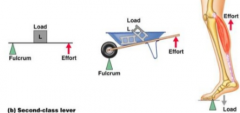
Second Class lever: - force on one end and the axis on the other end - the resistance is in between |
|
|
What is a third class lever |

Third class lever: resistance on one end and the axis on the other - the force is in between |

